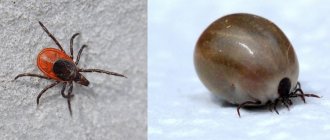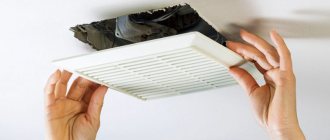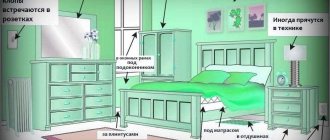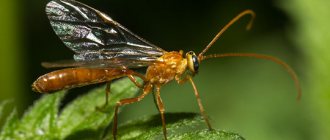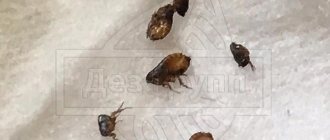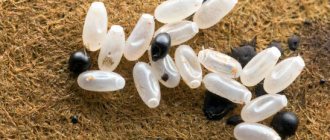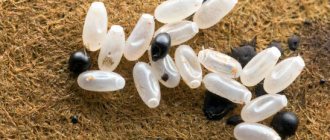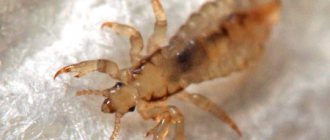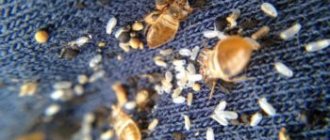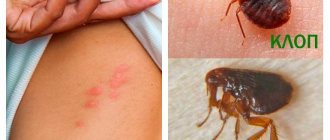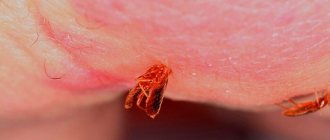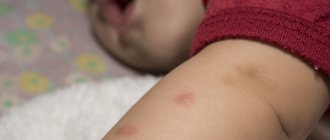Mouthparts and nutrition of bedbugs.
All representatives have a similar structure of the oral apparatus. The oral limbs form the alimentary canal, through which food is absorbed, and the salivary canal, through which saliva is injected. The maxillae and mandibles form a tuft running in the food canal and may have teeth or serrations at the ends. Solenophagous bugs. They apply the mouthparts to the host’s skin and anchor themselves with the jagged ends of the mandibles; moving the maxillae, they penetrate into the skin tissue and reach the blood vessel. Like lice, bedbugs depend partly for their nutrition on symbiotic bacteria. The bacteria are found in the intestinal epithelial cells of triatomine bugs; in cimicids, the bacteria are found in special two disc-shaped organs (mycetomes) in the abdomen on either side of the gonads. There is no evidence that these bacteria cause any harm to bedbugs. At the very least, mutualistic intestinal bacteria are necessary for the normal development of triatomine bugs - with artificial “disinfection” of bacteria, the bugs reach only the second or third stage of development and die.
Factors preventing reproduction
The reproduction of bedbugs, like all their life activities, strongly depends on the conditions in which they exist. The population growth rate is slowed down by:
- decrease in air temperature;
- decreased air humidity;
- lack of food.
Many owners use these factors to fight bedbugs without the use of aggressive chemicals.
Low humidity
The optimal relative humidity for the normal existence and rapid reproduction of insects is 40 - 60%. If the humidity level drops, the parasite eggs and they themselves dry out. Moreover, while larvae and adult bedbugs can replenish the lack of moisture by drinking blood, this method is not available for eggs.
Low temperature
A decrease in temperature significantly affects how long bedbugs and their eggs live. The larva that forms inside the egg is quite well protected, including from external influences. Therefore, a slight decrease in temperature will not affect the development of the embryo.
At a temperature of +15⁰С, parasites stop reproducing; at +10⁰С, the development of the embryo inside the egg stops. But research shows that even at sub-zero temperatures, the embryo inside the egg does not die immediately. So at -7⁰С its viability remains for more than a month.
Prolonged absence of food
With a long absence of food (more than 15 days), the parasite’s body gradually switches to an energy-saving mode. Bedbugs stop reproducing and move less. Gradually they fall into suspended animation, during which all vital processes slow down. In this state, insects can exist for up to 5 months.
Eternal problems from one bug
Even one particularly active male can cause not only a slowdown in the growth of the colony, but also its reduction. The fact is that insects do not know how to distinguish each other’s sex, so males sometimes try to mate with other males or nymphs who have not reached puberty. A puncture of the abdominal cavity can cause pathogenic microorganisms to enter the body, which is why the forcibly fertilized individual soon dies.
Pairing
Family Cimicidae - bed bugs.
About 20 species. Small wingless bugs that feed on the blood of warm-blooded animals, primarily birds or rodents. Cimex lectularius, C.hemipterus, Leptocimex boueti are known as bed bugs and attack humans. Cimex lectularius is a cosmopolitan species, but is predominantly found in temperate latitudes; C.hemipterus is more inclined to tropical areas; The distribution of Leptocimex boueti is limited to Western Africa. All three species that feed on humans also feed on bats. Bed bugs are not known to transmit any human diseases, but can be extremely annoying. People chronically attacked by bed bugs suffer from lack of sleep, ulcers at the site of bites, iron and hemoglobin deficiency, and, sometimes, due to mechanical transmission of the hepatitis B virus. Cimex hemipterus was experimentally infected with the human immunodeficiency virus, which remained viable in the bedbug within 8 days. The causative agents of a number of vector-borne diseases can remain alive in the body of bedbugs for a long time, but their role in transmission has not been proven. Bed bugs never defecate on the host's body. Morphology of bedbugs of the family Cimicidae. Tsimicides are red-brown bugs, up to 8 mm long. Flattened dorsoventrally. Their limbs do not have special devices for clinging to the host, but they allow the bedbugs to run quite quickly; bedbugs do not stay on the host for longer than 5-10 minutes. They absorb about 7 mg of blood at a time. Adults do not have wings, although nymphs develop rudimentary wings. Tsimicids have conspicuous compound eyes, but they do not have ocelli. The first thoracic segment forms a rim around the back of the head. The width of the tergite of the first somite of the chest exceeds its length. On the ventral side of the third somite of the chest, odorous glands open, secreting an oily secretion with an unpleasant odor characteristic of bed bugs. The smell probably serves as protection against predators.
How do they reproduce?
Bed bugs belong to the group of insects with incomplete metamorphosis. They do not have a pupal stage; larvae (or nymphs) develop into adults as a result of several molts. Thus, the full cycle includes 3 stages:
- egg;
- nymph;
- sexually mature individual.
The fertilization process is traumatic. In order for the seminal fluid to enter the female, the male cuts through her abdomen with his genital organ. Sperm penetrate the body cavity, some reaching the ovaries.
A male can copulate up to 200 times per day. The insect is not able to determine which sex an individual belongs to, so it mates with everyone. Males can attack each other. Someone else's sperm, which gets inside, does not die, but mixes with its own. Now, during copulation, such a male throws not only his sperm into the female.
After the first fertilization, the female can lay eggs for the rest of her life. Once inside, sperm are stored in the body and used when needed. The reproduction process does not stop; with normal nutrition, the female can lay up to 10 pieces. in a day. Hatching occurs on the 4th day or after 3 weeks. Insects quickly emerge at a temperature of 35°C and high humidity.
The masonry is well protected, so it is not always possible to destroy it with the help of poisons. If eggs are found, the nest should be treated when the larvae hatch.
Nymphs develop quickly only with good nutrition. If there is not enough food, then development slows down, but as soon as the insect receives a new portion of blood, the growth process resumes.
The best place for breeding is city apartments, where the temperature is high, there is always food and there are many hidden and safe places to live.
Biology of bedbugs.
Bed bugs are nocturnal, leaving their daytime shelters to feed on their hosts at night. In some people, the bites cause a minor reaction, while in others they cause significant inflammation as a result of an allergic reaction to the bedbug's saliva. Bedbugs can survive for a long time without feeding - adults up to 18 months. Cannibalism is common among bedbugs. Bed bugs can feed on the blood of small mammals and birds (chickens, pigeons). Females lay from 200 to 500 eggs in portions of 10-50 pieces. The eggs hatch after about 10 days, five successive nymphal stages, each of which must receive at least one blood meal. Blood feeding is necessary for the maturation of males and before the laying of eggs by females. Adults live about 14 months. The time between laying an egg and reaching maturity is between 37 and 128 days, but can be significantly longer in case of starvation.
Main breeding sites
Most often, bedbugs lay eggs in dark, hard-to-reach places close to a food source (a person’s sleeping place). Main breeding sites for bedbugs:
- mattress;
- bed frame;
- interior space or back wall of sofas, armchairs;
- internal surfaces of drawers and shelves;
- space behind the baseboard;
- the reverse side of paintings, mirrors hanging on the wall;
- sockets and switches;
- the back wall or interior of a household appliance.
In the mattress
Bedbugs often make nests behind peeling wallpaper or under loose floor coverings.
Epidemiology and control.
One female is enough to form a new focus of invasion. Control of bed bugs - application of long-lasting insecticides to likely harborage areas. Shows resistance to some insecticides. A high level of home cleanliness helps.
Family Reduviidae (Predators).
Most reduviids are predators that feed on other insects and are called “killer bugs.” Many of them can, but usually do not, bite people. The bites are quite painful. Extraintestinal digestion. One subfamily, Triatominae, is of great medical importance because its species act as a vector for Trypanosoma cruzi. Unlike assassin bug bites, triatomine bug bites are virtually painless to the host, as would be expected for a species that needs to suck blood and remain undetected for several minutes. They are also called kissing bugs, as they often bite a sleeping person on the lips.
Morphology of predatory bugs.
Triatomine bugs are quite large, up to 34 mm in length. Usually have wings. The head is narrow, large eyes are located on the sides in the middle or far back on the head. Behind the eyes there may be two ocelli. May make a squeaking sound.
Biology of predatory bugs.
Different types of reduviids are characterized by different habitats - on the ground, trees, human habitation. Eggs ranging from several tens to thousands are laid in the usual habitats of adults. Embryonic development - 2-3 weeks. There are usually five nymphal stages. Triatomine bugs are not necessarily located near a food source. Blood sucking is necessary for egg production and normal development of the nymphal stages, but adults can lay eggs without feeding if the nymphal stages have been well fed. The entire development cycle lasts from one to two years.
Epidemiology and control.
It is likely that all species of triatomine bugs are suitable hosts for Trypanosoma cruzi, but it is clear that species differ in their susceptibility to trypanosoma and their ability to serve as vectors. The importance of a bug species depends on the degree of its connection with human habitation (synanthropy). The most common vector species: Pantostrongylus megistus (Brazil), Triatoma infestans (Argentina), T.sanguisuga, T.dimidiata, Rhodnius prolixus. Relative importance varies by area. These insects are nocturnal; during the day they hide in brushwood, cracks, and thatched or thatched roofs. Low quality buildings play an important epidemiological role. The number of triatomine bugs in a building increases with the number of people living in it, but the number of bedbugs can be reduced by reducing the number of places of refuge - improving the design of the home, or tidying up the immediate environment. An important factor is the reduction of other sources of food for bedbugs - dogs, birds, rats. Use long-lasting insecticides around potential refuge sites. Painting with compounds containing insecticides (especially in wooden buildings). The diet of bedbugs greatly influences their resistance to insecticides - starving nymphs were 200 times more resistant than well-fed ones.
Order Hemiptera, or Bugs (Hemiptera) (F. N. Pravdin)
Hemipterans, or bugs, represent the largest order of insects with incomplete metamorphosis. Currently, over 30,000 species of bedbugs are known, distributed throughout the globe. Their name is Hemiptera
they received due to the peculiar structure of the front wings, which are sharply different from the hind wings, having the appearance of transparent membranes with a small number of veins. The forewings are transformed into elytra, heterogeneous in the degree of their chitinization. The main part of the elytra consists of hard chitin, while the apical part is membranous and the veins on it are clearly visible.
Some species of bedbugs are characterized by so-called wing dimorphism
, the essence of which is that, along with full-winged individuals with fully developed wings and elytra, they also have short-winged individuals.
Thus, in males of the pine beetle bug
(Aradus cinnamomeus), the elytra are normally developed, the second pair of wings is absent, while females are found in two forms - long-winged and short-winged (Fig. 219).
The long-winged female has both pairs of wings developed and is capable of flight, while the short-winged female cannot fly, since her elytra are shortened and wings are completely absent. Cases of complete loss of wings by bedbugs are much less common, as is the case, for example, with the bedbug
(Cimex lectularius).
Rice. 219. Pine grasshopper (Aradus cinnamomeus): 1 - male; 2 - long-winged female; 3 - short-winged female
In addition to the structure of the elytra, a characteristic feature common to all representatives of this order is their piercing-sucking
oral apparatus, shaped like a proboscis, extending from the anterior edge of the head and not fused with the prothorax (Fig. 220). The main part of the proboscis is represented by a strongly elongated, jointed lower lip, forming a deep groove on the inside, in which strongly modified upper and lower jaws are placed, having the appearance of thin and long bristles. The top of the proboscis is covered by a relatively short upper lip (Fig. 221).
Rice. 220. External structure of the bug: A - from the dorsal side; B - from the abdominal side; 1 - antennae; 2 - compound eye; 3 - crown; 4 - simple peephole; 5 - proboscis; 6 - pronotum; 7 - prothorax; 8 - mesothorax; 9 — shield; 10 - dense part of the elytra; 11 — membranous part of the elytra; 12 - metathorax; 13 - openings of the odorous glands; 14 - spiracles; I-VI abdominal segments
Rice. 221. Mouthparts of a bedbug: A - general view of the head (parts of the proboscis are spread apart); B - cross section (diagram); 1 - eyes; 2 - antennae; 3 - upper lip; 4 - upper jaws; 5 - lower jaws; 6 - lower lip; 7 - sucking groove; 8 - salivary duct
In connection with this specific structure of the oral apparatus is the feeding pattern of hemiptera: by piercing the integument of the body of an animal or plant, bugs suck out blood or cell sap. In this case, the puncture is made by the upper jaws, and suction occurs with the help of the mandibular bristles, which, when immersed in the victim’s body, tightly close, form two channels located one above the other. Liquid food is sucked through the upper channel, which is wider, and the saliva secreted by the bug flows down the lower channel. The lower lip does not penetrate the fabric and plays the role of a case that protects the bristles. In herbivorous bugs, the proboscis is usually long and thin; in a calm state, it is tucked under the body and hidden in a special groove located on the head and chest; in predatory species, the proboscis, on the contrary, is short, but thick and strong, arched in the form of a beak.
The size and shape of the body of hemipterans are extremely variable. Along with small species, less than 1 mm
, there are very large bugs, reaching 10
cm
.
Body shape often depends on the lifestyle of bedbugs and the nature of the environmental conditions in which they live. Usually the body is moderately flattened, more or less rounded, with wings folded flat on the back. Sometimes it takes on a rod-shaped form, and this occurs in various families. The South American stick insect
(Ghilianella filiventris) is more similar in appearance to a stick insect than a bug.
At the same time, there are species with an almost regular spherical shape; the latter is characteristic mainly of bugs that live in the thickness of sand on dunes or on hilly sand in deserts. In such psammophilous species from the family of earthen scale insects
(Cydnidae), the spherical shape of the body is combined with digging limbs, peculiarly adapted to movement in the thickness of loose sand (p. Stibaropus species, etc.). Strong flattening of the body is observed in parasitic bugs (parasites of bats, birds and humans), as well as in species that live under the bark of trees, in bark beetle passages and under other shelters.
The coloration of hemipterans is often dominated by bright colors in contrasting combinations (black, yellow, red, etc.), which makes them noticeable against the surrounding background. This coloration is characteristic, for example, of a skinny bug
(Lygaeus equestris, table 37, 2) and toy soldier (Pyrrhocoris apterus, table 37, 3).
The skinny bug is bright red with a black pattern and white spots on the upper side of the body, the antennae and legs are black; length 10-12 mm
. Already in early spring it can be found in large quantities on the walls of houses, on the bark of trees and on various herbaceous plants. The soldier is approximately the same size, red with a black belly and a black pattern on the elytra; its elytra are somewhat shortened, and its wings are often completely absent.
Such a bright color is clearly of a demonstrative nature and goes well with the presence of odorous mammary glands in bedbugs, which secrete a specific liquid with a sharp, characteristic “bedbug” odor. The paired openings of the ducts of these glands open on the metathorax between the places of articulation of the second and third pairs of legs. The secretion secreted by the glands is acidic; its unpleasant odor is determined by cimicic acid C15H2802. In bugs that live in aquatic environments, as well as in a number of predatory species, scent glands are absent or poorly developed. Despite the fact that many species of hemipterans are found in nature in large quantities, the fertility of their females is generally low and ranges from several dozen eggs to 200. Eggs can have an oval, cylindrical, spindle-shaped or irregularly rounded shape. Their characteristic feature is the presence of a special cap on the upper pole, which opens when the first instar larva emerges from the egg.
Rice. 222. Bugs: 1 - rod-shaped predator (Ghilianella filiventris); 2 - earthen shield bug (Stibaropus hohlbecki)
Some bedbugs have a distinct form of caring for their offspring. In this regard, the edge-leaf species
(Phyllomorpha laciniata), found in the Caucasus and Crimea. Its pronotum and abdomen are expanded and bear leaf-shaped translucent lobes; antennae, legs and the entire surface of the body are covered with numerous long spines. The ocher-yellow color and leaf-shaped shape make it look like a leaf that has dried out and cracked at the edges. The female lays her eggs on the dorsal surface of the male, where they become stuck between the spines and remain there until the larvae hatch.
The number of larval stages in hemiptera is in the vast majority of cases five, rarely four. Postembryonic development lasts from several weeks to two years. The larvae are similar in appearance to the adults, from which they differ primarily in their smaller size and a number of morphological characteristics (the absence of simple ocelli, a smaller number of antennal segments and tarsi, etc.). The wing rudiments appear in third instar larvae; with each molt they increase in size, but even in fifth-instar larvae they occupy a lateral position and do not touch along the inner edge. Hemipteran larvae also have odorous glands, numbering 1-3 pairs, but the ducts of these glands open on the dorsal surface of the abdomen.
The most ancient finds of insects identical to the modern order of Hemiptera date back to the Mesozoic era, where they were mainly represented by specific families not found later in either the Tertiary or modern fauna. In the Tertiary period, at least from the lower Oligocene, most modern families of bugs became isolated.
Currently there are approximately 50 families, of which about 40 (over 2000 species) are found in the USSR. The vast majority of species inhabit predominantly tropical and subtropical regions of the globe.
Among bugs there are many species that are predatory or have a mixed diet, but herbivorous forms predominate. Some of them are dangerous pests of agricultural forest plants (Table 37).
Table 37. Ground bugs: 1 - ringed predator (Rhinocoris annulatus); 2 - skinny bug (Lygaeus equestris); 3 — soldier bug (Pyrrhocoris apterus); 4 — sorrel bug (Coreus marginatus); 5 — rapeseed bug (Eurydema oleracea); 6 - mustard bug (E. festiva); 7 - painted bug (E. ornata); 8 - harmful turtle (Eurygaster integriceps); 9 - Austrian bug (E. austriacus); 10 - Moorish bug (E. maura); 11 — sharp-headed shield bug (Aelia acuminata); 12 - green wood bug (Palomenaprasina); 13 - Italian bug (Graphosoma italicum); 14 — horsefly (Deraeocoris punctulatus); 15 - colony of soldier bugs
Table 37. Ground bugs: 1 - ringed predator (Rhinocoris annulatus); 2 - skinny bug (Lygaeus equestris); 3 — soldier bug (Pyrrhocoris apterus); 4 — sorrel bug (Coreus marginatus); 5 — rapeseed bug (Eurydema oleracea); 6 - mustard bug (E. festiva); 7 - painted bug (E. ornata); 8 - harmful turtle (Eurygaster integriceps); 9 - Austrian bug (E. austriacus); 10 - Moorish bug (E. maura); 11 — sharp-headed shield bug (Aelia acuminata); 12 - green wood bug (Palomenaprasina); 13 - Italian bug (Graphosoma italicum); 14 — horsefly (Deraeocoris punctulatus); 15 - colony of soldier bugs
Turtle bugs cause great damage to grain crops
(
family
Scutelleridae). Representatives of this family are characterized by a highly chitinized pronotum, behind which there is a convex shield that reaches the apex of the abdomen and covers most of the elytra. The external resemblance of the body to the shell of turtles served as the basis for the Russian name for these bugs. The family includes about 600 species, of which 55 are found in the USSR.
Rice. 223. Leafweed (Phyllomorpha laciniata) with eggs
The most harmful representatives of the family in our conditions are three species: harmful turtle
(Eurygaster integriceps),
Moorish bug
(E. maura) and
Austrian bug
(E. austriacus) (Table 37, 8, 9, 10). All of them are dangerous pests of grain crops. The feeding and reproduction of turtle bugs occurs mainly in fields sown with wheat, barley and rye, where they arrive in the spring from their wintering grounds. Increased feeding of overwintered bugs on the stems of cereals leads to the death of the stems. The period of laying eggs by females lasts about a month. On average, 70-100 eggs are laid, in groups of 14; clutches are placed on the leaves and stems of cereals, on dead weeds and even on lumps of soil. Embryonic development occurs within 9-16 days; postembryonic development lasts 35-40 days, and the larva molts 5 times.
By the time the grain is filled with winter crops, bugs and their larvae crawl onto the ears. When sucking grains, bugs secrete saliva, which dissolves proteins and destroys gluten. As a result, the grain shrinks and loses weight; its germination rate decreases. Flour made from such grain is unsuitable for baking.
By the time the grain is harvested, the bulk of the fledged bugs migrate from the fields to their wintering sites, which are areas with woody vegetation, where they overwinter mainly under fallen leaves. Flights are sometimes carried out over distances of several hundred kilometers. In Central Asia, turtles can fly into the mountains to heights of up to 1400-2000 m
. In coastal areas, during stormy weather, many flying bugs die at sea. In 1941, in the area of Novorossiysk, after a storm, more than one and a half billion bedbugs were thrown ashore by waves.
There are many agricultural pests in
shield insect
family (Pentatomidae).
the mountain bug
(Dolycoris penicillatus), a dangerous pest of wheat in Uzbekistan, Kazakhstan and Turkmenistan,
is very peculiar This species winters in the mountains at an altitude of about 2000 m
. At the end of March - beginning of April, it flies from wintering grounds to the valleys and begins laying eggs on wild weed vegetation. Each clutch is a pile containing from 6 to 28 eggs. Eggs develop in 10-12 days; The larvae emerging from them molt five times with intervals between moults of 4-6 days. Adult bugs move to wheat fields. Sucking wheat during grain filling leads to underdevelopment of part of the grains in the ear. Beginning in July, the mountain bug migrates to the mountains, where it forms clusters under bushes of wormwood and other plants on rocky slopes.
cruciferous bugs stands out.
(species of the genus Eurydema, table 37, 5, 6, 7).
They are similar in biology, but differ in the nature of their geographical distribution. The rapeseed bug
(E. oleracea) is found almost everywhere in the USSR, except for the northern regions;
The mustard bug
(E. festiva) does not spread north of 55° N.
sh.; in Siberia it is replaced by the Siberian cruciferous bug
(E. gebleri);
the painted bug
(E. ornata) is harmful in the steppe and forest-steppe zones, and
the Central Asian cabbage bug
(E. maracandica) is harmful in the Central Asian republics.
All of them are distinguished by their bright green or blue color with a metallic sheen, mixed with spots and stripes of red, yellow and white. They feed mainly on wild and cultivated cruciferous plants. They can seriously harm cabbage, rapeseed and mustard. Adult bugs overwinter, gathering in groups under various plant debris, often in leaf litter under the cover of woody plants. They spend the entire winter in a torpid state, and in the spring they leave their wintering grounds and fly away in search of food plants. Soon, after a period of intense feeding, the bugs mate and the females begin laying eggs. The eggs are placed on the leaves and stems of cruciferous plants in characteristic clutches in two rows of six eggs each. The egg looks like a small barrel with a lid. Depending on weather conditions, the egg stage lasts from 6 to 30 days. Postembryonic development - from 25-30 (in the south) to 50-60 days (in the north); therefore, in the southern regions there may be two or even three generations.
Larvae and adult bedbugs suck cell sap from their food plants. In those places where the skin was pierced by the proboscis, discolored white spots appear on the leaves and stems. If young plants are damaged, they turn yellow, are stunted and wither. Damage to flowering shoots on the seed plants leads to falling flowers or stunted seeds.
In the south, for example in Ukraine, Crimea and Moldova, you can often find the pear lacemaker
(Stephanitis pyri), belonging to
laceweed
family (Tingitidae).
It has a black body, only about 3 mm
, with yellowish legs and antennae. The wide transparent elytra of this bug are characteristic: their numerous veins form a thin mesh. This pest lives on apple, pear and other fruit trees, as well as linden. After mating, which occurs in the spring, the female lays eggs in the leaf tissue on the underside, in groups of 16-20 pieces. The development of eggs lasts 20-30 days, and the development of larvae - 20-25 days. During the year it can produce 2-3 generations. The leaves of apple and pear trees damaged as a result of sucking by bugs and their larvae dry out, which leads to underdevelopment of the fruit. Adult bedbugs overwinter under fallen leaves or in crevices of dead tree bark.
Rice. 224. Pear laceweed (Stephanitis pyri)
Typical predatory hemiptera are representatives
the raptor
family (Reduviidae). These are usually large bugs, less often small in size, with a more or less cylindrical head, elongated in length and extending behind the eyes in the form of a neck; the pronotum is divided by a constriction into a narrower anterior and wider posterior part. Most species have normally developed wings, although short-winged and wingless forms are also found. The legs of predators, especially the hind ones, are relatively long, but they move slowly. They feed on various insects. In total, over 3,000 species are known, of which about 90 are found in the USSR.
In nature, predators can be found in a wide variety of conditions: in trees, in grass, on the ground, under stones. Some bugs of this family (Empicoris culiciformis and others) were found in trees in the nests of squirrels, magpies and shrikes. In Central Asia, a number of species hide during the day in the burrows of vertebrate animals and only at night do they come to the surface in search of prey. For example, the Fedchenko reduvium
(Reduvius fedtschenkia-nus) occupies the burrows of gerbils and the steppe tortoise, and another species of this genus (R. christophi) occupies the burrows of the slender-toed ground squirrel.
Some predators are found in domestic buildings, where they hunt for synanthropic insects. domestic predator
(Ploearia domestica), which looks like a spider, kills flies in houses at night in the Crimea and Transcaucasia.
The Central Asian predator
(Stenolemus bogdanovi), similar to a large mosquito, crawls along walls and ceilings, especially in corners covered with cobwebs.
of the dirty predator
(Reduvius personatus)
is interesting This is a large bug, 16-19 mm
, dark brown in color with reddish legs. It also lives in buildings and storage areas. Its larvae are well camouflaged by dust and small debris stuck on the body between the bristles, as a result of which they resemble lumps of dirt. Africa is considered the homeland of this bug, from where it, having become a human cohabitant, occupied all of Europe, Canada and the eastern states of North America.
Rice. 225. Dirty predator (Reduvius personatus)
A special place among hemipterans is occupied by the so-called bed bugs
(
family
Cimicidae), a characteristic feature of which is a round or oval, highly flattened body with sharply shortened elytra. The name given to these bugs is not accurate: there are not many of them among them, actually “bed bugs,” i.e., those closely associated with human habitation - only a few species. The remaining species of this family (there are about 30 of them) are parasites that suck the blood of vertebrates (bats, pikas, birds).
bedbug is widely and notoriously famous.
(Cimex lectularius) is a cosmopolitan that has spread throughout the world following man. Apparently, its homeland was in the countries surrounding the Mediterranean Sea, where it was known to the ancient Greeks and Romans long before our era. In the 11th century he was already well known in Central Europe, and in the 16th century. The conquerors of the New World brought it to the American continent. In Central Asia, the bedbug began to appear as a human parasite only in the sixties of the last century with the arrival of Russian troops in Turkestan. For 20 years, he occupied all the cities and villages of Turkestan.
However, in addition to human dwellings, the bedbug is also found in nature: in tree hollows, in caves, etc. It is known to be found in the Baharden underground cave in Turkmenistan. The cave, located on the northern slope of Kopet-Dag, is difficult to access and rarely visited by people. The bugs were found in that part of it that is completely devoid of light; here they are found in the droppings of bats and even in the water of an underground lake, where, apparently, they fall from the places where these animals accumulate on the cave vaults. In the Daurian steppe, the bug lives in the burrows of rodents (Daurian pika, herd vole, etc.), as well as in the nests of tree sparrows, wagtails and swallows built on human buildings. Our knowledge of this side of the life of a bedbug is still very fragmentary, and we should expect many more interesting facts about its occurrence in a natural environment.
The bedbug is reddish-brown in color, 4.5-6.5 mm
, in short and dense brownish hairs, with shortened elytra and a characteristic pronotum, the anterior angles of which, in the form of wide lobes, cover the base of the head on both sides.
Severe flattening of the body and loss of wings are the result of parasitism. The legs of a bed bug are typical walking ones, adapted for fast movement: in one minute it can run a distance of 1 m
, i.e. a distance 200 times greater than the body length of the insect itself. Its olfactory organs are very well developed: the bug detects its owner by smell at a great distance. The characteristic odor of a bedbug, distributed by the secretion of the odorous glands, is pungent and unpleasant.
Rice. 226. Bedbug (Cimex lectularius)
The bed bug is nocturnal; During the day, he hides under wallpaper, under baseboards, in cracks in floors and ceilings, in the folds of mattresses, in furniture and in other secluded places. Only bedbugs that have starved for a long time attack a person during the day or at night under artificial light; usually they suck human blood at night in the dark. Itching and pain that occur at the site of the bug's proboscis injection are caused by the introduction of saliva into the skin, which has irritating properties. When bed bugs reproduce massively, frequent injections disrupt a person’s normal sleep. In addition, it is possible that the bug is a carrier of some infectious diseases, although this issue has not yet been completely resolved.
Bedbugs lay eggs in the same places where they hide during the day. The female lays up to 12 eggs per day; in laboratory conditions, it was possible to obtain several hundred eggs (even over 500) from one female. The higher the room temperature, the faster the eggs develop; therefore, under different conditions, it lasts from 4-7 days to a month. At temperatures below +10°C, the development of eggs stops, and at 4-6°C below zero, they can last no more than one and a half months. In the same way, the development of larvae depends on temperature, so it stretches from 28-30 days to 6-8 weeks. To move to the next instar, the larva needs to pump blood. Without this, the next molt is delayed, sometimes for a very long time - up to 18 months. An adult bedbug lives up to 14 months.
The wide and rapid spread of the bedbug is also facilitated by the fact that, in addition to humans, it also attacks bats, some mouse-like rodents, and various birds, including chickens.
Until now, we have become acquainted with hemipterans, whose life takes place in a terrestrial environment. But there are some families of this order, which in their development are associated with water and have amazing adaptations to living in an aquatic environment. That is why they are favorite objects of observation on school excursions.
Among aquatic bugs (Table 38),
rowing bug
family (Corixidae) is especially rich in species, of which there are about 600 species in the world fauna.
Some of them in their distribution extend beyond the Arctic Circle and are found in the tundra. Comb bugs are relatively small bugs with a wide head and a relatively flattened body. Our largest representative of this family is Corixa dentipes, common in the forest zone, reaching a length of 13-16 mm
;
there are small species, only about 2 mm
(Micronecta minutissima).
Table 38. Water bugs: 1 - common smoothie (Notonecta glauca); 2 - float (Naucoris cimicoides); 3 - rower (Gorixa dentiped); 4 - water scorpion (Nepa cinerea); 5, 6 — larva and eggs of a water scorpion; 7 - ranatra (Ranatra linearis); 8 - pond runner (Hydrometra); 9 — water strider (Gerris); 10, 11 - water strider eggs and larvae
Table 38. Water bugs: 1 - common smoothie (Notonecta glauca); 2 - float (Naucoris cimicoides); 3 - rower (Gorixa dentiped); 4 - water scorpion (Nepa cinerea); 5, 6 — larva and eggs of a water scorpion; 7 - ranatra (Ranatra linearis); 8 - pond runner (Hydrometra); 9 — water strider (Gerris); 10, 11 - water strider eggs and larvae
A characteristic feature of rowers is that each pair of limbs has a unique structure. The legs of the first pair are short, with single-segmented tarsi shaped like a spatula, seated in males with a row of small teeth. This spatula is the musical apparatus of the male. Sitting under water, clinging to a plant with its middle legs, it, moving its front paws along the surface of its proboscis, makes chirping sounds. The middle legs of the bug are thin and elongated, also with a single-segmented tarsus, on top of which there is a pair of arched, pointed claws, with their help the bug clings tightly to the plant. The legs of the rear pair are flattened, densely covered with hairs and serve as oars, allowing rapid movement in the water.
Rowers breathe atmospheric air, for which they from time to time rise to the surface of the reservoir and, exposing the front part of the body from the water, draw air into the trachea through the thoracic spiracles. When moving in water, exhaust air is gradually released by the abdominal spiracles and covers the lower surface of the body with a silvery film.
Rowers live mainly in stagnant or slowly flowing bodies of water; they are much less common in running water. Their life does not stop even in winter, when they can be caught from under the ice. Most species are good fliers and often fly to the light at night. Some paddlefish can be found in huge numbers. Even in the last century, local species of paddlefish were imported to England from Mexico to feed poultry. It is estimated that each barrel brought in contained about 250 million bedbugs.
The eggs of paddlefish are more or less spherical in shape and slightly pointed at one of the poles (Fig. 227). The female attaches them using a special adhesive substance to plants and other underwater objects, placing them in small piles.
Rice. 227. Eggs of water bugs: 1 - bug (on water buttercup); 2 - smooth; 3 - ranatras; 4 - water scorpion; 5 - floating; 6 - large water strider
Paddlefish feed on both plant and animal foods (algae, mosquito larvae).
In appearance, rowers resemble smoothies
(
family
Notonectidae), which, although represented in our country by a limited number of species (6-7), are nevertheless forms common in our fresh water bodies.
The most common species is the common smoothie
(Notonecta glauca, table 38, 1).
An adult bug reaches a length of about 1.5 cm
. The shape of the smoothie's body is characteristic: it is flat on the bottom and convex on the top, making it a little reminiscent of a boat turned upside down. The body is greenish-white with brownish or yellowish elytra.
Just like in rowers, the hind legs of the smoothfish are turned into peculiar oars, densely covered with swimming bristles. With their help, he moves quickly in the water. In this case, the bug swims with its ventral side up, and then it really resembles a miniature submarine. At rest, the smooth fish can “hang” completely motionless at the surface of the water on its hind legs widely spaced to the sides, looking for prey with its large red eyes. Gladysh is a voracious predator that attacks other aquatic insects and even small fish. Therefore, in some cases it can be harmful to fisheries. The bug's proboscis, although short, is very hard and sharp. If you carelessly take the smoothie in your hands, it can pierce the skin with its proboscis, and the injection will be painful due to the corrosive effect of the saliva injected into the wound.
The breathing hole, through which the smoothie takes in atmospheric air, is located at the rear end of the abdomen. When diving, the bug takes with it an air bubble that covers its body like a thin layer of mercury.
Gladysh fly well and can fly long distances at night, populating new bodies of water. Females lay eggs inside the tissues of underwater plants. The eggs have an elongated, oval shape.
Along with rowers and smoothies, floating water
(Naucoris cimicoides, table 38, 2) is a representative
floating
family (Naucoridae), distributed mainly in the tropics.
Plata has a wide, slightly convex, ovoid body, about 1.5 cm
; it is greenish-yellow in color with a shiny pronotum covered with brown dots. The swimmer has highly modified forelimbs, which are a very mobile grasping apparatus, well adapted for catching prey, which can be insect larvae, mollusks and small fish. The hind limbs of the swimmer are swimming, covered with hairs. However, the swimmer not only swims well, but also crawls on plants. Rising to the surface of the reservoir, the swimmer stores atmospheric air, filling it with the free space formed between the slightly convex elytra and the body. Plat eggs are elongated, slightly curved; the female deposits them inside the stems of underwater plants.
Bedbugs belonging to the family
of water scorpions
(Nepidae) are very peculiar.
Their front legs, like those of swimmers, are transformed into grasping limbs, but the other two pairs are walking. This determines the nature of their movement - water scorpions move slowly, clinging to plants with their claws. At the posterior end of the body they have a long process, which is a respiratory tube consisting of two grooves facing each other. The bug exposes the end of this breathing tube from the water and uses it to draw air under the elytra. Water scorpion eggs are equipped with long thread-like appendages through which a supply of air is transported into the egg. Water scorpions are already known from Upper Jurassic deposits. Currently, there are about 150 species of these insects, distributed mainly in tropical areas. the water scorpion
(Nepa cinerea, table 38, 4) and
ranatra
(Ranatra linearis, table 38, 7) are widespread Both of them are found in bodies of water with standing or slowly flowing water, overgrown with plants.
The water scorpion has a completely flat, oval, leaf-shaped body, gray or brownish in color; the top of the abdomen is red along the edges. It reaches about 2 cm in length; the breathing tube is almost twice as long as the body. Thanks to the peculiar grasping limbs and the general contour of the body, this insect actually looks more like a scorpion than a bug. A water scorpion sitting at the bottom resembles a rotten leaf covered with silt. This “rotting leaf” comes to life when a victim appears in front of it. Then it quickly throws forward its front legs, reminiscent of huge curved jaws, and, capturing the prey with them, plunges its proboscis into it. The female lays eggs in the tissue of aquatic plants; in this case, all seven thread-like appendages of the egg, unfolding in the form of a rosette, remain outside.
Ranatra has a long, narrow body, up to 3.5 cm
, ending in a very long breathing tube; it is yellowish-gray in color, the top of the abdomen is red, the lower wings are transparent. The shape of the body and its color resemble a dirty twig lying at the bottom of a pond. The lifestyle is similar to that of the water scorpion. Ranatra eggs have only two respiratory processes.
Close to water scorpions is
Belostomatidae
family , which differ in that their hind legs are swimming rather than walking.
Although they also have respiratory tubes, the latter barely protrude beyond the end of the abdomen or are completely hidden. Belostomatids are giants among bugs: among them there are forms reaching 10 cm
. They feed on fish fry and tadpoles. These bugs have a unique way of caring for their offspring: the female lays eggs on the dorsal surface of the male, where they are tightly glued to the elytra and thus remain there for quite a long time (10-12 days) until the larvae hatch. Belostomatids live mainly in tropical countries. In the fauna of the USSR they are represented by 2 species living in the Far East.
Rice. 228. Indian Belostoma (Belostoma indicum)
Several families of bugs, united under the general name “water striders,” have adapted to living on the surface of the water surface, along which they move with no less ease than any land insects on the ground. An example is the representatives of the family of
true water striders
(Gerridae).
These insects can be found in any body of water, from a small puddle to the ocean. This family includes about 300 species, most of which inhabit tropical areas. There are 12 species found in the European part of the USSR. One of our largest species is the great water strider
(Limnoporus rufoscutellatus), reaching a length of 13-17
mm
. Its elongated narrow body is reddish in color and covered with velvety hairs, making the underside of the body appear silvery or yellowish-shiny. Well-developed wings and elytra are folded along the abdomen. The structure of the limbs of water striders is very characteristic. The front pair is shorter than the others; although it does not have the structure typical of grasping legs, it is used by the insect to capture the victim. The middle and hind legs are very long and thin; they are lubricated from below with a fatty substance and therefore are not wetted by water. This determines the nature of the water strider’s movement: with its legs spread wide to the sides, it quickly glides along the smooth surface of the water, like a speed skater on ice. If an obstacle in the form of leaves or branches is encountered on the way, the bug makes a strong leap and jumps over it. Jumping movements also help him escape from underwater enemies.
Water striders eat small insects that fall to the surface of the water. Females lay eggs throughout the summer, so larvae of different ages can always be found along with adults. Eggs are laid on aquatic plants. Larger species place them in rows on the surface of the leaf, and the eggs are interconnected by mucous secretions, forming a long gelatinous cord. Small species lay eggs in plant tissue. In autumn, with the onset of cold weather, water striders leave the pond and, crawling ashore, hide in secluded places - under the bark of stumps, in moss, etc.
A special genus of water striders (Heterobates) is known from Central Asia, adapted to life on rivers with very strong, fast currents (Syr Darya, Amu Darya, Vakhsh, etc.) Marine water striders
(Halobates), living on the surface of tropical seas. They were found in the open ocean several thousand kilometers away from the coast. Apparently, due to this way of life, sea water striders have reduced wings, and the whole body is very compact, with a shortened abdomen.
Coastal bugs are also associated with bodies of water
(
family
Saldidae);
they live along the banks of rivers, streams, lakes and seas. They can be found near plants growing near water, on large boulders in rivers, or running through silt and mud in shallows. These are small predatory forms, 2-8 mm
, usually painted in more or less dark colors, with a wide head bearing large bulging eyes.
They move quickly, fly well and make large jumps. One of the most common species, distributed throughout the European part of the USSR, is the jumping shorebird
(Saldula saltatoria), black with light spots on the elytra, 3.5-4.5
mm
.
Rice. 229. Jumping shorebird (Saldula saltatoria)
Preparations for killing house bugs
— Microencapsulated. These include “Xulat S25”, “Minap 22” and household chemicals of the “GET” brand. These products are among the safest chemicals for humans, with long-term effects. By using them, you can avoid a relapse that can occur after the bedbug eggs mature. - Powder. These include: “Karbofos”, “Chlorofos”, “Mikrofos”, “Riapan”, “Pyrethrum”, “Neopin” and so on. Some of them have an effect only on insects ("Pyrethrum"), others have a sharp unpleasant odor ("Karbofos"), others are intended only for professional use ("Mikrofos"), and others are dangerous even for humans ("Chlorofos"), so they used only in exceptional cases. But all of them are long-acting drugs, and they are most effective. Newly appearing or hatching larvae from eggs will not cause the rebirth of these bloodsuckers in the apartment. —Liquid preparation. “Insekta Dibro-fin”, “Primadid”, “Lakterin”, “Foxide”, “GET” “Forsyth” and many others. Fighting bedbugs at home using these drugs is quite effective. Most of these products are highly concentrated, so the liquid must be diluted before using them. Such preparations are more economical, since even a small bottle can treat a fairly large area. Instructions for using these products are written directly on their packaging. — Aerosol sprays. “Carbozol”, “Perfos-P”, “Prima-U”, “Dichlorvos”, “Reid”, “Raptor” and others. After bed bugs appear, everyone probably knows how to get them out using aerosols. When destroying common flies, all of us probably used Dichlorvos. The principle of operation of these drugs is the same. Having a strictly targeted effect, the poison will penetrate into the most inaccessible places: cracks, splits, under furniture that cannot be moved, behind the baseboard, etc. The chemicals of these drugs are quite effective, so they are often used when fighting bedbugs in an apartment independently is still justified. — Traps and other means: “Actellik”, “Su-sol”, “Insectolan”, “Combat”, “MINAP-22”, “Chlorpirimark”, “Phospholan”, “Diphocarb”, “Pyrethrum”, “Neofos-2” ", "Empire 20", "Prima-71", "Tetrix", "KRA-Killer", "Clean House", "Fufanon", "Effective Ultra", "Cucaracha", "Karbofos".
Bedbugs in an apartment: causes of appearance and methods of detection
Depending on the species, bedbugs eat a wide variety of foods. However, those parasites that we sometimes encounter in our own homes feed on human blood. Another feature of “domesticated” parasites is their instant spread. If someone has these “pets” in an apartment in a multi-storey building, then there is a high probability that they will soon occupy your home.
Ways to enter the house
The habitat for bedbugs in an apartment can be different: the upholstery of the sofa, the mattress on the bed, the wardrobe in which fur coats and jackets are stored, baseboards, the space behind wall paintings. Bedbugs live in the apartment and behind furniture pushed up against the wall, as well as behind ceiling panels and wallpaper that has come off the wall. It is noteworthy that insects that feed on human blood, contrary to the prevailing stereotype, do not disdain ideal cleanliness. They don’t care at all who lives in the house - a standard married couple doing wet cleaning and dusting every day, or a free artist scattering garbage around the apartment. The main thing for them is the availability of food.
- "Gift" from guests. One of the ways bedbugs enter an apartment is through migration on clothes or shoes. Insects can get into your home thanks to the guests you invite. But you yourself can bring parasites without even knowing it.
- Ineffective disinfestation. One of the most common reasons for the appearance of biting parasites is ineffective baiting of insects by neighbors. Pest control, which does not result in the death of insects, as a rule, only leads to the fact that a horde of small creatures “moves” to a neighboring apartment, where living conditions are more acceptable and comfortable.
- "Present" from abroad. Often, bedbugs appear in the sofa as a result of a tourist trip. Imagine that you flew away on vacation and checked into a hotel where bedbugs live. Those, in turn, moved into your suitcase and successfully traveled thousands of kilometers in it. It is enough to bring just one female into the house, so that after a few weeks the bedbugs begin to crowd you into your own apartment.
- From livestock. At risk are those people who live near poultry farms and farms with small livestock. Human blood is much more attractive to small bugs than animal blood. Therefore, they are always happy to move closer to the “upright” food. By the way, these creatures are almost never parasitic on cattle: a bug simply cannot bite through the thick skin of a sheep or cow. But forest bugs often appear in an apartment after a trip to the forest, as well as in cases where weather conditions provoke high humidity in their habitat area.
- When buying furniture. It doesn't matter whether you buy a used set second-hand or a mahogany bed from a showroom. Along with new furniture, bedbugs can easily be carried into the house. Therefore, carefully check the furniture before bringing it into the apartment. Especially things purchased from other owners, and items that were in the show room of a furniture store.
Signs of "occupation"
Determining whether there are bedbugs in an apartment is quite simple. Parasite activity begins around 3:00. If you suspect something, cover your bed or sofa with a white sheet and set an alarm for the specified time. After the signal, stand up sharply and turn on the lights in the room. If there are parasites, you cannot help but notice them on snow-white bedding. There are three more signs that indicate that there are parasites in the house.
- Characteristic smell. Small insects of this type have glands that repel enemies, but attract individuals of the opposite sex. A person experiences this “aroma” in different ways. Some say that the smell of bedbugs is similar to the smell of sour berries. Others insist that it resembles the aroma of cheap cognac. In any case, the bug gland smells clearly and quite recognizable. So trust your sense of smell.
- Bites on the skin. Bedbugs bite is also very typical. The bites form a single chain. For some they swell with blisters, for others they remain small dots. There are also those for whom bedbug bites provoke a widespread allergic reaction. It is impossible not to notice marks on the skin. But sometimes it’s easy to confuse them with mosquitoes. Most often, bedbugs bite the upper and lower limbs, as well as the neck and face.
- The appearance of waste products. A bedbug nest will sooner or later make itself known by the presence of waste products of parasites. As a rule, this is an accumulation of chitinous remains and insect excrement in the under-bed space or near the baseboards. Anyone who regularly cleans the apartment will not ignore this obvious disgrace.
How to reduce reproduction and development
Bedbugs, which take 10-14 months to develop (from egg to adult), require destruction from the moment they are detected in the house. As you can see, these bloodsuckers and their offspring are quite resistant to unfavorable conditions. However, you can still get rid of them. By starting active control of parasites during this time, the population increase can be slowed down.
Most owners, having noticed bedbugs, try to get rid of them on their own. To do this, you can use many traditional methods, for example, “freezing” or exposure to too high a temperature. You can also try purchasing special chemicals that, according to manufacturers, will help remove parasites. However, even today it is impossible to find a drug for independent use that will help destroy all masonry.
That is why the best solution to prevent the development of bedbugs is to call specialists at home. Using special tools and innovative equipment, they will carry out disinfestation of the premises (and, if necessary, repeat it) in order to destroy the entire population of house bugs.
